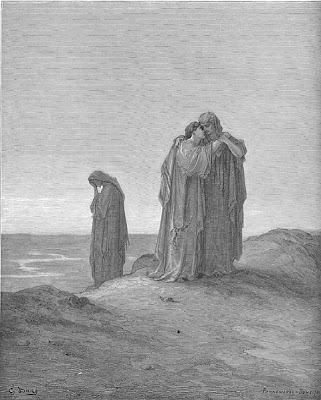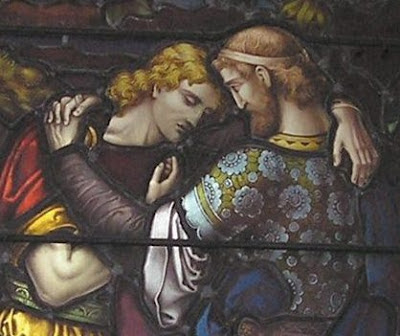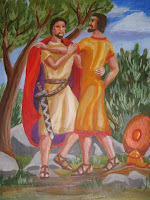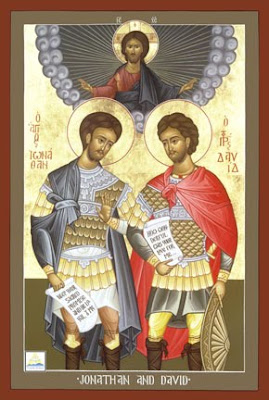"Rainbow Reflections" by Kittredge Cherry
Welcome the new year by lighting rainbow candles for Bridge of Light, a new winter holiday honoring LGBT culture.
![]() |
Rainbow Arch candle holder |
People celebrate Bridge of Light by lighting six candles, one for each color of the rainbow flag, on New Year’s Eve -- or from Dec. 26 to Jan. 1, one candle per day.
Each candle stands for a spiritual principle and its expression in the lives and history of LGBT and queer people. Feel free to improvise other methods, such as using colored paper to fold origami cranes.
The candles are intended to provide a starting point for individual and group meditations on these principles:
1. Red - The Root of Spirit (Community)
2. Orange - The Fire of Spirit (Eros, sexuality, passion)
3. Yellow - The Core of Spirit (Self-esteem, courage)
4. Green - The Heart of Spirit (Love)
5. Blue - The Voice of Spirit (Justice, self-expression)
6. Purple - The Eye of Spirit (Wisdom)
7. All Candles - The Crown of Spirit (Spirituality)
Together these colors form a rainbow, a time-honored symbol of a bridge between two worlds: heaven and earth, East and West, male and female, queer and non-queer.
The principles are beautifully expressed in a new benediction prayer written for Bridge of Light by Yewtree (Yvonne Aburrow) of the
Dance of the Elements Blog:
Let us embody the values of the rainbow flag of lesbian, gay, bisexual and transgender people.
Red is the root of spirit, found in beloved community,
Orange is for Eros, the fire of spirit, the experience of erotic connection,
Yellow is for self-esteem, the strong core of spirit,
Green is for love, the heart of spirit, the verdant growth of the soul,
Blue is for self-expression, the voice of spirit, calling out for justice,
Purple is the eye of spirit, which sees inwardly with the eye of wisdom.
And all the colours together form the crown of spirit, the experience of spirituality.
Joe Perez, author of “
Soulfully Gay![]()
,” founded Bridge of Light in 2004. It has obvious parallels to
Kwanzaa, the African-American cultural holiday started by Ron Karenga in 1966.
“Bridge of Light is an interfaith and omni-denominational cultural and spiritual tradition,” Perez says. “The annual winter ritual...has helped to draw attention to the positive contributions made by members of the LGBT community in the areas of spiritual growth, inner transformation, and religious leadership.” One of his articles on the subject is
The Seven (Revised) Principles of Bridge of Light. (GaySpirituality.com)
The following summary of the seven principles of Bridge of Light includes historical time periods, foods and more about the chakras, the energy centers of the human body. I synthesized and developed this info based on the resource links at the end of this post. For Jesus in Love readers I highlighted Christian history with links to LGBT Saints. The seven principles are also matched with the seven models of the queer Christ from gay theologian
Patrick S. Cheng’s new book “
From Sin to Amazing Grace: Discovering the Queer Christ.![]()
. A variety of systems have developed to associate each chakra with a power animal. A few are suggested here, but feel free to follow your intuition.
1. Red - The Root of Spirit (Community)
Red evokes life, energy and blood. Shadow side: violence/death.
Affirmation: I am.
Time period: Before Christ / Before the Common Era
Celebrate same-sex love in goddess worship, paganism and other pre-patriarchal spiritualities, in ancient myths and cultures, and in the Hebrew Scriptures/Old Testament.
Living and Self-Loving Christ (sin as shame, grace as pride)
Mary, Diana and Artemis: Feast of Assumption has lesbian goddess roots
David and JonathanRuth and Naomi
Foods: Root vegetables (carrots, beets, potatoes, etc.), protein-rich foods, sweet and spicy tastes.
Animals: Elephant, snake, mole, underground creatures.
2. Orange - The Fire of Spirit (Eros)
Orange evokes fire, passion, sexuality and relationships. Shadow side: lust/addiction.
Affirmation : I feel.
Time period: 1st - 4th centuries
Celebrate same-sex love in the life of Christ, among early Christians, in the late Roman Empire and other cultures.
Erotic Christ (sin as exploitation; grace as mutuality)
Historical Jesus and the Beloved DiscipleMary and MarthaSergius and BacchusPerpetua and Felicity
Foods: Foods growing from ground-level to 2 feet (melons, strawberries, squash, etc.), sweet and salty tastes.
Animals: Crocodile, dolphin, underwater creatures.
3. Yellow - The Core of Spirit (Self-Esteem)
Yellow evokes courage, confidence and personal power. Shadow side: fear/anger.
Affirmation: I do.
Time period: Middle Ages, 4th - 15th centuries
Celebrate same-sex love in medieval times. Queer medieval Christians include pairs of lovers in monasteries and convents, writers of homoerotic verse, and cross-dressing women. Medieval mystics describe erotic-ecstatic union with God.
Out Christ (sin as the closet; grace as coming out)
Brigid and Darlughdach (c.451-525)
Symeon of Emessa and John (c. 522-c. 588)
Hildegard of Bingen (1098-1179)
Aelred of Rievaulx (c.1110-1167)
Francis of Assisi (1181-1226)
Rumi (1207 - 1273)
Julian of Norwich (1342-c. 1417)
Foods: Foods growing 2-6 feet above the ground (grains, sunflower seeds etc.), bitter and minty tastes.
Animals: Ram, bear, birds, flying creatures.
4. Green - The Heart of Spirit (Love)
Green evokes growth, nature, balance and compassion. Shadow side: jealousy/greed, hatred.
Affirmation: I love.
Time period: Renaissance, 15th-17th centuries (c. 1400-1699)
Celebrate same-sex love in the era that included the Age of Discovery, the Protestant Reformation and the invention of the printing press.
Transgressive Christ (sin as conformity; grace as deviance)
Joan of Arc (c.1412-1431)
John of the Cross (1542-1591)
Juana de la Cruz (1648-1695)
Gay Popes, Papal Sodomites (Queering the Church Blog)
Foods: Green leafy vegetables (broccoli, spinach, green tea, etc.), sour and savory tastes.
Animals: Antelope, wolf, mammals.
5. Blue - The Voice of Spirit (Justice and Self-Expression)
Blue evokes peace, communication and independence. Shadow side: depression/arrogance.
Affirmation: I speak
Time period: Modern, 1700 to 1950
Celebrate same-sex love in modern times, including gender role evolution in Romanticism, Transcendentalism, secular philosophy, and the movements for women’s suffrage and abolition.
Liberator Christ (sin as apathy; grace as activism)
Bernardo de Hoyos (1711-1735): Mystical same-sex marriage with Jesus
Jemima Wilkinson / Publick Universal Friend (1752-1819) Queer American preacher
John Henry Newman (1801-1890) and Ambrose St. John
Christina Rossetti (1830-1894) Poet who wrote Christmas carols
We’wha of Zuni (1849-1896)
Foods: Food that grows 6 feet or more above ground (apples, oranges, avocadoes, etc.), sour and salty tastes.
Animal: White elephant, personal power animal, humanity.
6. Purple - The Eye of Spirit (Wisdom)
Purple evokes vision, intuition and understanding. Shadow side: passivity/nightmares.
Affirmation: I perceive
Time period: 1950 to present
Celebrate same-sex love and gender role defiance in recent LGBT, queer, feminist and black liberation movements, including the struggle for LGBT religious rights. LGBT-affirming churches and religious institutions are founded. Pluralistic expressions of sexuality and gender multiply, but some are martyred in anti-gay hate crimes.
Interconnected Christ (sin as isolation, grace as interdependence)
Saints of StonewallHarvey MilkBayard RustinMychal Judge: Gay saint of 9/11
Matthew ShepherdPauli Murray
Foods: Dark purple foods (blueberries, purple grapes, red wine, etc.), subtle tastes (poppyseed, lavender, etc.).
Animal: None. Ancestors and spirit guides.
7. All Colors / White - The Crown of Spirit (Spirituality)
When all the colors of the rainbow mix, they create white light, evoking universal consciousness.
Affirmation: I understand.
Time period: Now and the future
Celebrate same-sex love now and in the future! Be a witness of love in all its expressions. Sainthood is a state to which all are called.
Hybrid and All-Encompassing Christ (sin as singularity; grace as hybridity)
Animal: Egg, eagle,
Rainbow Serpent.
Foods: Fasting. Instead of eating, inhale incense and smudging herbs such as sage. Or… Celebrate with a slice of rainbow cake!
Bridge of Light continues to evolve. Aburrow suggested adding sacred foods, such as “rainbow-tinted marble cake maybe, or one food of each colour?”
I like the idea of doing a daily candle for each color, but every year Dec. 26-31 is such a busy week for me! I wonder if Bridge of Light could also be celebrated at the summer solstice in connection with LGBTQ Pride?
___
Links to other resources for Bridge of Light:
Rainbow Christ Prayer: LGBT flag reveals the queer Christ (Kittredge Cherry and Patrick Cheng)
"
Seven Shrines of the Body" by artist Richard Stott
Animal Chakra SymbolsRainbow Bridge of Jose Argüelles
The Story of the "Queer Saints and Martyrs" by Terence Weldon
Author Carolyn Myss connects the seven chakras with the seven sacraments of the church in her book “
Anatomy of the Spirit: The Seven Stages of Power and Healing![]()
.”
CD set of meditations based on the chakras, “
Activating Your Chakras Through the Light Rays![]()
.” It’s definitely “new age,” but it’s the best of its kind.
S(t)even Years: A 7-year art project based on the chakras by Steven Reigns
“The Myth, Magic, and Science of the Rainbow” by by Cedar Stevens
http://naturalmagickshop.com/articles/The-Myth-Magic-and-Science-of-the-Rainbow.html
Happy Bridge of Light, everybody! Like the rainbow, may we embody all the colors of the world! Be renewed and refreshed as the New Year begins! May 2014 bring everyone peace, health and prosperity!
___
Image credits:
Chakra images by Anodea Judith of
SacredCenters.com
Rainbow 7th chakta image: Thousand-petaled lotus flower (Sahasrara) carrying a sacred flame (Namam) from
Wikimedia Commons
____
This post is part of the
LGBT Calendar series by Kittredge Cherry at the Jesus in Love Blog. The series celebrates religious and spiritual holidays, holy days, feast days, festivals, anniversaries, liturgical seasons and other occasions of special interest to LGBT and queer people of faith and our allies.
Copyright © Kittredge Cherry. All rights reserved.http://www.jesusinlove.blogspot.com/Jesus in Love Blog on LGBT spirituality and the arts

























 by Robert A. Bernstein
by Robert A. Bernstein by Amity Pierce Buxton.
by Amity Pierce Buxton.





 .’” from University of Texas Press. The anthology is edited by Alma Lopez and Alicia Gaspar de Alba. The two women were married in 2008, during the first brief period when same-sex marriage was legal in California.
.’” from University of Texas Press. The anthology is edited by Alma Lopez and Alicia Gaspar de Alba. The two women were married in 2008, during the first brief period when same-sex marriage was legal in California.
 by Kittredge Cherry..”
by Kittredge Cherry..”












 by Theodore Jennings is a comprehensive book that explores the possibility of Lazarus as Jesus’ lover -- and all the other major queer theories about the beloved disciple.
by Theodore Jennings is a comprehensive book that explores the possibility of Lazarus as Jesus’ lover -- and all the other major queer theories about the beloved disciple. by Stephen C. Carlson.
by Stephen C. Carlson. ” where Jesus describes raising Lazarus from the dead:
” where Jesus describes raising Lazarus from the dead:























 , famous but struggling with a secret gay identity, commissioned it in 1983. He asked for an icon that symbolized the act of offering his own sexuality and affection to Christ. Research and reflection led Lentz to paint Christ being embraced by his beloved disciple John, based on an icon from medieval Crete.
, famous but struggling with a secret gay identity, commissioned it in 1983. He asked for an icon that symbolized the act of offering his own sexuality and affection to Christ. Research and reflection led Lentz to paint Christ being embraced by his beloved disciple John, based on an icon from medieval Crete.


 .” Jesus, the narrator, remembers the day he met John:
.” Jesus, the narrator, remembers the day he met John:















 ” by Symonds.
” by Symonds.



 ,” founded Bridge of Light in 2004. It has obvious parallels to
,” founded Bridge of Light in 2004. It has obvious parallels to  . A variety of systems have developed to associate each chakra with a power animal. A few are suggested here, but feel free to follow your intuition.
. A variety of systems have developed to associate each chakra with a power animal. A few are suggested here, but feel free to follow your intuition.








 .”
.”  .” It’s definitely “new age,” but it’s the best of its kind.
.” It’s definitely “new age,” but it’s the best of its kind. 







 .” She writes:
.” She writes: . “My guess is that they were people who today would be termed transwomen,” she writes in the brochure “Gender Identity and Our Faith Communities.”
. “My guess is that they were people who today would be termed transwomen,” she writes in the brochure “Gender Identity and Our Faith Communities.”

 .”
.”
